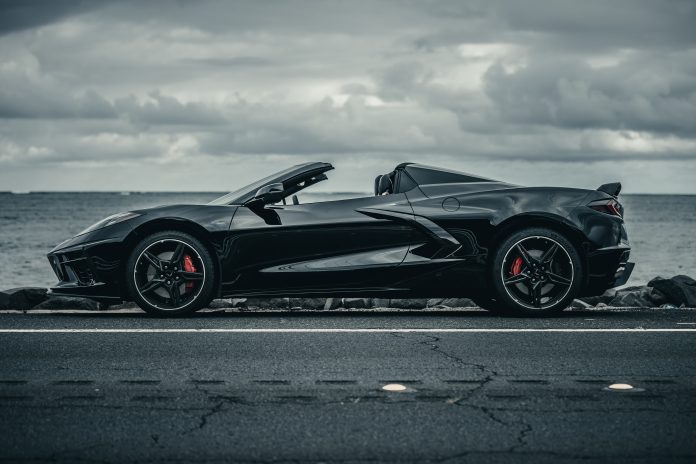It restates the obvious that every segment of the auto industry is undergoing changes due to the rush toward electrification. Nowhere is this more evident than with the sports cars produced by the Big Three. This year is the last for the Dodge Challenger, and the Chevrolet Camaro as we know it will bow out in 2024.
However, the American sports car is far from dead, as an all-new Ford Mustang will start hitting showrooms this summer, and Chevrolet recently announced the hybrid Corvette E-Ray.
Let’s briefly explore Detroit’s role with sports cars over the past decades and how this set the stage for what’s coming down the pike. Neither Ford, GM, nor Stellantis is abandoning the sports car, but each automaker is taking a different approach to satisfying their customers’ speed needs.
Overview: American sports cars through the decades
While not the first American sports car, the Chevrolet Corvette gets the credit for popularizing the idea of a stylish two-door vehicle that didn’t look like your neighbor’s coupe. Interestingly, the initial Corvettes (1953-1954) came with a lackluster six-cylinder engine that almost killed the idea of a mass-market sports car. But, introducing a punchy V8 for 1955 gave the Corvette needed performance credentials.
Fast forward to the 1960s, arguably the most transformative decade for sports cars in the U.S. The 1964 Pontiac GTO launched the muscle car craze. A short time later, the Ford Mustang made “pony car” a household term (although the Valiant-based Plymouth Barracuda gets the credit for being the first pony car to market, beating the Mustang by two weeks).
Meanwhile, the early years of the 1970s helped send off the muscle car era in style before the Dodge Challenger and other memorable nameplates got the ax. Onerous emissions regulations and the energy crisis kept the auto industry in a hangover for years.
Yet, the 1980s saw a greater introduction of technology, like turbocharging and computerization, to satisfy environmental and fuel economy concerns. The fastest American production car in 1987? The turbocharged six-cylinder Buick Grand National/GNX. This was the decade when Detroit realized that sophisticated engineering could enable them to have their cake and eat it, too, as far as sports cars.
The 1990s and 2000s marked the introduction of more technology and the influence of Japanese automakers and badge engineering (remember the Dodge Stealth and Plymouth Laser?). GM buried the Chevrolet Camaro and Pontiac Firebird in 2002.
While not quite a snore-fest, these decades laid the groundwork for a sports car mini-renaissance as Dodge resurrected the Challenger in 2008 and Chevrolet brought back the Camaro in 2010.
 |
But eventually, every boom turns into a bust, and that’s where we are today. Dwindling sports car sales, with the realization that there’s still a market (albeit smaller) for selling something with two doors that’s speedy.
Here’s where three American brands are headed.
Chevrolet: Taking the middle road
Admittedly, adding hybrid technology to a Corvette is no giant leap forward but a stop-gap approach for Chevrolet. Going all-electric with the company’s original sports car might be too much of a jump for Corvette loyalists at this point. Rumors abound the Camaro will resurface as an all-electric sedan, but until there’s an official announcement, this is anybody’s guess.
Dodge: Jumping in with both feet
Despite hyping Hemi and Hellcat engines for years, Dodge is wholeheartedly casting off gasoline for electricity. The Stellantis brand has already begun to show off the Dodge Charger Daytona SRT Concept, an all-electric coupe that pays homage to the Charger name. Dodge is promising Mopar fans that the 800-volt Banshee propulsion system and artificial exhaust sound will still make hearts race. Undoubtedly, Ford and GM will be paying close attention.
Ford: Hanging on to the past
Mustang lovers were anxious that the seventh-generation Mustang would embrace electrification somehow (like with a hybrid system). Still, Ford enabled ICE lovers to breathe a collective sigh of relief. The 2024 Mustang is carrying forward with the turbo four-cylinder and V8 engines. It’s a safe bet the next Mustang will be radically different, but that’s years away.
Did you enjoy this article? Please share your thoughts, comments, or questions regarding this topic by connecting with us at newsroom@cbtnews.com.
Be sure to follow us on Facebook, LinkedIn, and TikTok to stay up to date.
While you’re here, don’t forget to subscribe to our email newsletter for all the latest auto industry news from CBT News.






